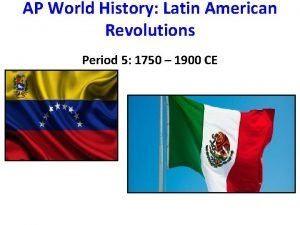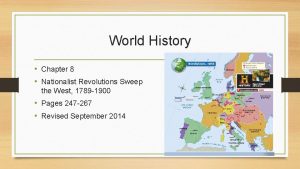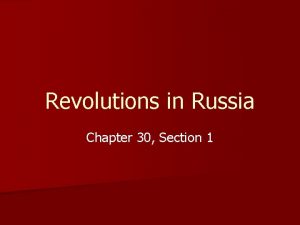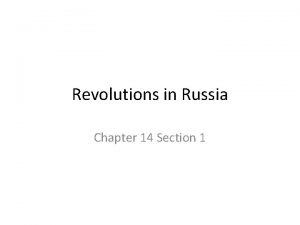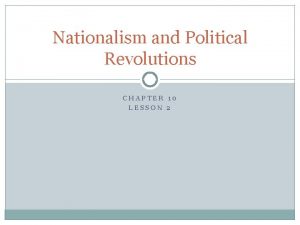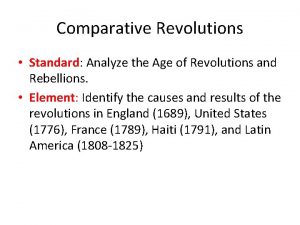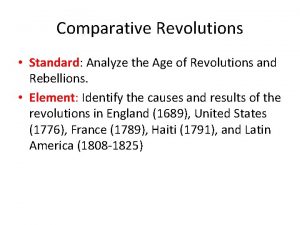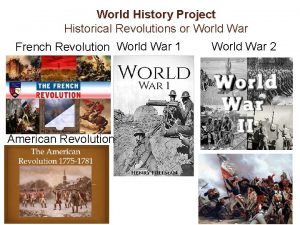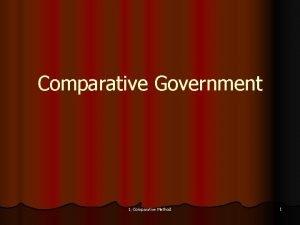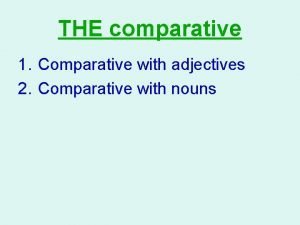Comparative Revolutions AP World History Comparative Revolutions p









- Slides: 9

Comparative Revolutions AP World History

Comparative Revolutions p The following is a summary of Crane Brinton’s model of revolutions taken from his book entitled Anatomy of a Revolution. p This model helps us to understand the causes, course of events, and results of social and political revolution, but it is not a definitive solution to the all important historical problem of understanding revolution.

The Causes of Major Revolutions 1. People from all classes are discontented. p 2. People feel restless and held down by unacceptable restrictions in society, religion, the economy, or government. p 3. People are hopeful about the future but are being forced to accept less than they expected. p 4. People are beginning to think of themselves as belonging to a social class and there is bitterness between social classes. p

The Causes of Major Revolutions, cont. p 5. Social classes closest to one another are the most hostile. p 6. Scholars and thinkers give up on the way their society operates. p 7. The government does not respond to the needs of its society. p 8. Government leaders and the ruling class begin to doubt themselves, and some join with opposition groups.

The Causes of Major Revolutions, cont. p 9. The government is unable to get enough support from any group to save itself. p 10. The government cannot organize its finances correctly. It is either going bankrupt, trying to tax heavily and unjustly, or a combination of both.

The Course of Major Revolutions p 1. Impossible demands are made on the existing government which if granted would mean the end of the government. p 2. The government makes an unsuccessful attempt to suppress the revolutionaries. p 3. Revolutionaries gain power and appear to be united. p 4. Once in power, the revolutionaries quarrel among themselves and unity dissolves.

The Course of Major Revolutions, cont. p 5. Moderates gain control on the revolution but fail to satisfy more radical elements. p 6. Radicals progressively gain power until lunatic fringe gains control. p 7. A strong man or dictator emerges and assumes great power.

The Course of Major Revolutions, cont. p 8. Extremists attempt to create a utopia by introducing their whole program and punishing their opponents. p 9. A period of terror occurs. p 10. Moderate groups regain power and the revolution ends.

The Results of Major Revolutions p p p Consider the following questions when evaluating the results of a revolution or when considering a revolution as a success or a failure. 1. Did the ideals of the revolution change as its leadership changed? 2. Were the original goals of the revolution achieved? At what point? Were these achievements conserved? 3. Which social classes gained most from the revolution? Which lost? Did the original ruling group or individuals from this group return to power? 4. How was the old political, social, and economic order of society changed as a result of the revolution?
 Simon bolivar definition ap world history
Simon bolivar definition ap world history Revolutions and national states in the atlantic world
Revolutions and national states in the atlantic world Ap world history chapter 25 africa and the atlantic world
Ap world history chapter 25 africa and the atlantic world Dangerous world tour setlist
Dangerous world tour setlist Chapter 8 nationalist revolutions sweep the west
Chapter 8 nationalist revolutions sweep the west Chapter 30 revolutions in russia
Chapter 30 revolutions in russia Chapter 14 revolutions in russia
Chapter 14 revolutions in russia Revolutions in europe and latin america section 2 quiz
Revolutions in europe and latin america section 2 quiz Revolutions sweep europe
Revolutions sweep europe Nationalism and political revolutions lesson 2
Nationalism and political revolutions lesson 2
